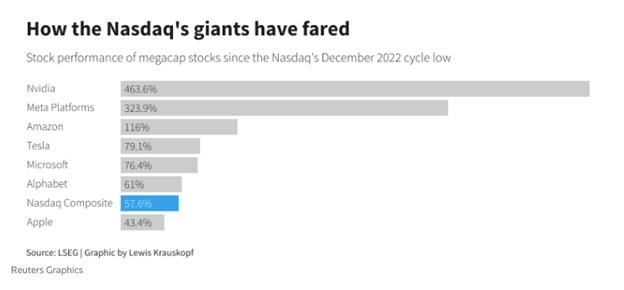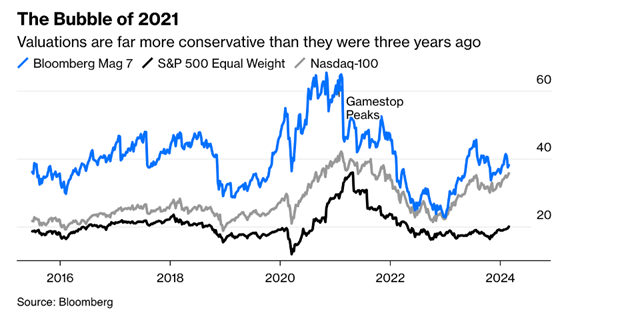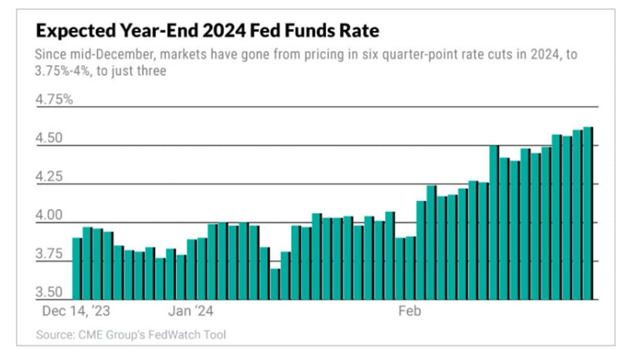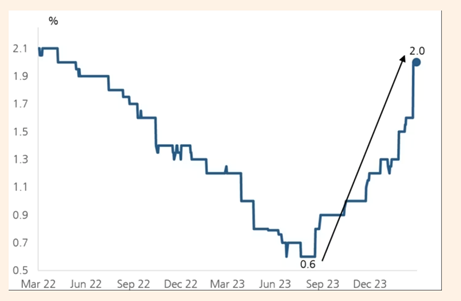Display results

28 March
Record High Stocks Across the Board
Quick Take: Major stock indices continued to reach all-time highs, as the Nasdaq joined the party.[1] Expectations of fewer rate cuts did little to dampen the rally.
February saw the stock market surge again, as the S&P 500 kicked off its best start to the year (S&P 500 +5.2% in February) since 2019.[2] Market breadth was strong, reflecting a wider recovery across sectors with over 71% of stocks in the S&P posting positive returns.[3]
Investors pushed interest rate cut expectations later into 2024, putting downward pressure on US Treasury bond prices.[4] Rates on 10-year US Treasury yields finished February with its largest monthly increase since the last quarter of 2023 – resulting in lower prices.[5]
Tech Dominance (Again)
The major indices, Dow Jones Industrial Average and S&P 500, had been drumming up a string of record highs since December 2022 and late January 2023, respectively. [6] The rally hit a closing low in December 2022 as investors dumped high value growth stocks sensitive to high rates, leaving the Nasdaq down more than 30% from its November 2021 record high. [7]

Source: https://www.reuters.com/markets/us/futures-ease-caution-prevails-ahead-inflation-data-2024-02-29/
Since then, the Nasdaq has risen 24%.[8] The Nasdaq’s rise has been led by Nvidia, whose 250% rise over the past year had understandably given investors pause, but its jaw dropping 265% rise in quarterly revenues silenced doubters.[9] The results released late February blew past the most optimistic estimates of Wall Street analysts.[10]
Bubble Talk
Each record high has naturally sparked discussion around a bubble, though Bridgewater founder Ray Dalio notes that the US stock market does not seem to be in a speculative bubble.[11] According to Dalio, although the Magnificent 7 tech stocks leading the charge seem a bit frothy (when assets prices are detached from true intrinsic value), he believes sentiment is still bullish and doesn’t see excessive leverage.[12]

Source: https://www.bloomberg.com/opinion/articles/2024-03-04/gold-rally-the-fed-isn-t-gonna-carry-that-weight?srnd=undefined
Stock valuations are technically far more conservative now than they were three years ago, when meme stocks drove tech names higher.[13] In other words, current prices, while high, are not completely absurd. Of course, the collective expectation that a bubble hasn’t arrived yet could possibly propel gains.
Fewer and Later Rate Cuts
So where does monetary policy figure in all of this? The Fed has remained cautious in its rhetoric, given the economy’s remarkable resilience. Although US prices increased in January, the annual inflation figure was the lowest in three years, which keeps a mid-year interest rate cut on the table.

Source: https://www.investors.com/news/economy/fed-rate-cuts-federal-reserve-sp-500/
Since mid-December, markets have gone from expecting six quarter-point rate cuts this year to just three. Three cuts fall right in line with the Fed’s guidance from December.[14]
Fed chair Jay Powell has emphasized the importance of getting the timing of rate cuts right. Starting too early could reverse the progress on inflation and require even tighter policy.
How have markets been so resilient when they now expect fewer interest rate cuts? The reality is that the economy is barely slowing down, and the Fed pivot – the announcement that rates have peaked – has offered a strong tailwind to growth since December.[15] With inflation looking relatively tame, continued strength in the US economy, and a strong employment market, a slower start to the rate-cut cycle might not faze investors. Wall Street strategists have had to scramble to upgrade stock market forecasts.[16]
This is a big shift from near-certain talk of recession going into 2023.
This chart of US forecasts for economic growth as measured by real Gross Domestic Product (GDP) in 2024 shows the about-face.

Source: https://www.ft.com/content/0d58cb77-c771-4b05-8e7b-fca2a53e4912
Looking Ahead
Where do we go from here, with stocks at all-time highs? The S&P 500 has risen 7.5% more since reaching all-time highs last December, which tends to make investors nervous about the possibility of a drop.[17]
At this point the hardest thing to do, yet usually the most reasonable, is to stay invested. It’s impossible to predict the direction of the market, and often a fool’s errand to try. Time in the market is more important than timing the market. However, if you anticipate needing funds in the next 6 to 12 months, we believe it is a good time to raise cash.
Looking back in history hints at this – US stocks have been at a record high in 30% of the all the months going back to 1926.[18] In fact, the market often outperforms in the 12 months after reaching an all-time high.[19] Staying in the market delivers meaningful benefits, whereas if you switched into cash at similar points, over 10 years you would have lost 23% of your wealth.[20]
Of course, history doesn’t always repeat itself. Markets tend to follow their own course without taking instructions from the past. They are also meant to be forward looking.
As the first quarter of 2024 ends and we welcome longer spring days with more sunshine, we hope to reconnect soon if we haven’t yet spoken in the new year. Tax season is in full swing, and 1099s continue to become available. The IRA and Roth IRA deadlines are also upon us, mirroring the tax deadline of April 15th. If you have questions, don’t hesitate to reach out to us or your trusted tax professionals as these critical deadlines approach.
As life presents fresh challenges and opportunities, we are committed to providing you a resilient financial strategy that adapts to your evolving needs while keeping your long-term goals in focus. Thank you for your ongoing trust in us and Happy Spring!
Your Friends at JSF
The information expressed herein are those of JSF Financial, LLC, it does not necessarily reflect the views of NewEdge Securities, Inc. Neither JSF Financial LLC nor NewEdge Securities, Inc. gives tax or legal advice. All opinions are subject to change without notice. Neither the information provided, nor any opinion expressed constitutes a solicitation or recommendation for the purchase, sale or holding of any security. Investing involves risk, including possible loss of principal. Indexes are unmanaged and cannot be invested in directly.
Historical data shown represents past performance and does not guarantee comparable future results. The information and statistical data contained herein were obtained from sources believed to be reliable but in no way are guaranteed by JSF Financial, LLC or NewEdge Securities, Inc. as to accuracy or completeness. The information provided is not intended to be a complete analysis of every material fact respecting any strategy. The examples presented do not take into consideration commissions, tax implications, or other transactions costs, which may significantly affect the economic consequences of a given strategy. Diversification does not ensure a profit or guarantee against loss. Carefully consider the investment objectives, risks, charges and expenses of the trades referenced in this material before investing.
Asset Allocation and Diversification do not guarantee a profit or protect against a loss.
The Bloomberg Barclays U.S. Aggregate Bond Index measures the investment-grade U.S. dollar-denominated, fixed-rate taxable bond market and includes Treasury securities, government-related and corporate securities, mortgage-backed securities, asset-backed securities and commercial mortgage-backed securities.
The S&P 500 Index is an unmanaged, market value-weighted index of 500 stocks generally representative of the broad stock market.
TLT-iShares 20 Plus Year Treasury Bond ETF seeks to track the investment results of an index composed of US Treasury bonds with remaining maturities greater than twenty years.
The Nasdaq Composite is a market-capitalization-weighted index consisting of all Nasdaq Stock Exchange listed stocks that are not derivatives, preferred shares, funds, exchange-traded funds or debenture securities.
Treasury Bond- is a U.S. government debt security with a fixed interest rate and maturity between two and 10 years.
Gross domestic product (GDP) is a monetary measure of the market value of all the final goods and services produced in a specific time period. GDP is the most commonly used measure of economic activity.
By clicking on these links, you will leave our server, as they are located on another server. We have not independently verified the information available through this link. The link is provided to you as a matter of interest. Please click on the links below to leave and proceed to the selected site.
Sources:
[1] Nasdaq notches first record high close since 2021 | Reuters
[2] S&P 500 Notches Best February In 9 Years (forbes.com)
[3] S&P 500 Notches Best February In 9 Years (forbes.com)
[4] Review of markets over February 2024 | J.P. Morgan Asset Management (jpmorgan.com)
[5] 10-year Treasury yield ends with biggest monthly jump since October | Morningstar
[6] Nasdaq notches first record high close since 2021 | Reuters
[7] Nasdaq notches first record high close since 2021 | Reuters
[8] Climbing can tell us much about stock market peaks (ft.com)
[9] Climbing can tell us much about stock market peaks (ft.com)
[10] Climbing can tell us much about stock market peaks (ft.com)
[11] Ray Dalio says the U.S. stock market ‘doesn’t look very bubbly’ (cnbc.com)
[12] Billionaire Ray Dalio Doesn’t Think the Stock Market Is in a Bubble (businessinsider.com)
[13] Gold Rally: The Fed Isn’t Gonna Carry That Weight – Bloomberg
[14] Federal Reserve keeps key interest rate unchanged | AP News
[15] Hard –> soft –> refuelling landing
[16] Hard –> soft –> refuelling landing
[17] Climbing can tell us much about stock market peaks (ft.com)
[18] Climbing can tell us much about stock market peaks (ft.com)
[19] Climbing can tell us much about stock market peaks (ft.com)
[20] Climbing can tell us much about stock market peaks (ft.com)
Read more